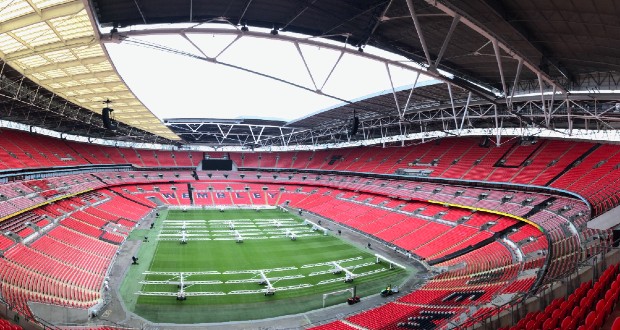The first rotatable loudspeaker system suspended from wire ropes in a UK stadium is ensuring that every fan experiences the same high-quality sound, wherever they are sitting.
After two lost years for sports and live-music events as a result of the pandemic, London’s Wembley Stadium is enjoying its longest-ever concert season – thanks to a d&b sound solution that is the first rotatable loudspeaker system suspended from wire ropes in a UK stadium.
Stadium director Liam Boylan said: “One area that we knew would add value to our guests and clients was upgrading the bowl audio. The previous system was not specifically designed to be used for the delivery of music – and that was becoming increasingly apparent.”
German audio technology and solutions company d&b audiotechnik was briefed with ensuring the person sitting in Wembley’s front row experienced the same quality of sound as the person in row 48 of level five. Additionally, the system needed to be lightweight to stay within roof-loading limits, appeal to the music industry and sports organisations, and integrate with the stadium’s existing network.
The main loudspeaker system, including corner fills, comprises Special Version Stadium (SVS) V-Series and Y-Series line arrays. SVS models are acoustically identical to their standard versions, with extra protection for use in harsh environments and full consideration of wind loads and seismic activity. The complete system integrates with Wembley’s existing control infrastructure via MediaMatrix.
One of the main advantages of the d&b system is the ability to rotate the arrays. During sports events, they are in their default position, on axis with the spectators’ seating position. In concert mode, the arrays are rotated to optimise the acoustic path between the stage and the audience in the upper tiers, enhancing the listening experience. Installation-specific 30D amplifiers are housed on two 52m-high gantries running along the length of the pitch.
Mervyn Nock, the Football Association’s AV manager, said: “With the d&b system, PAVA compliance was a given. So instead of thinking about baseline intelligibility, we could focus on performance quality expectations. Before the installation, we rigged an array of d&b loudspeakers to give Wembley’s senior leadership team and various stakeholders a comparison. The difference surpassed everyone’s expectations; not only was music much clearer, cleaner and brighter, but speech was so much more intelligible, more authoritative.”
Steve Jones, d&b’s head of education and application support for EMEA, was tasked with the system design. “Because the Wembley bowl is so high and so steep, we needed to propose a single system that was up to the task of properly covering the large vertical geometry from the front row to the back of the upper tiers, provide horizontal consistency, and be suitable for both sports events and augmenting concert productions,” he said.
Jones realised that for optimum performance from a single system, he needed to talk to Wembley’s technology consultant, Vanguardia, about the possibility of rotating the arrays and deploying them at an overall lower height, in the North and South stands. “It is now possible for Wembley to create upper and lower zones, to easily offer multiple performance layouts and to switch from sports mode to concert mode without any compromise in quality,” he said.
Nock added: “With so many different types of events at Wembley, d&b’s R1 software enables us to quickly configure the system and cater for any event specific PA requirements – for example, reducing the sound levels in temporary press/broadcast locations.”
The sound system was installed by AV company RG Jones during winter 2019 and was completed in time for the EFL Carabao Cup Final in February 2020.
Wembley’s resident DJ, Tony Perry, put the new audio system through its paces in June 2021, at the delayed Euro 2000 tournament. “I’ve been fortunate to play at many stadiums,” he said. “At Wembley last summer, there was a notable difference in clarity and depth. Whether the stadium was at its lowest 20,000-capacity audience, or during the epic closing ceremony, the sound was remarkably well balanced. Perhaps what stood out most, was how the sound maintained clarity both at low level, and when being pushed to its loudest. It’s something I hadn’t experienced in a stadium environment before.”
Reference : AVinteractive


